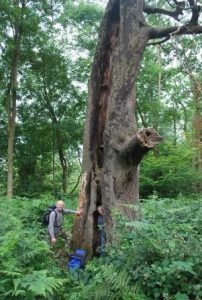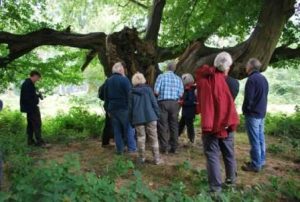The Saxon boundaries of Meopham in King Athelstan’s grant of AD939
Athelstan’s charter, as we understand it, abuts parts of the southern boundaries of Nurstead and Cobham parishes (and of the study area) and it provides some idea of the differences between Saxon and Medieval settlements. It also gives the earliest known use of the name of Cobham. We have adopted the texts and translation of this charter as given on the Kings College, London “Electronic Sawyer” website as being authoritative and the most recent. It is numbered S447 and is headed:
A.D. 939. King Athelstan to Eadwulf, minister: grant of 12 hides (mansae) at Meopham, Kent
The charter gives the bounds in Old English as follows:
Þis synt þa land gemæro to Meapham On suþan 7 on westeweard setl þonan norþ fram setle to netles stede to þære hane þonan norþ on gerihte andlang hrycges oþ hredles stede þæt forþ þonan to fearn leage geate þonan norþ þonan to Cobba hammes mearce þonan east on gerihte to heorot felda geate fram þam geate east 7 suþ on hludes beorh of þam beorge forþ be þære mearce oþ þone calewan stoc þonan suþ to blacan meres geate þæt suþ þonan on þone oran foran wiþ eastan ecgulfes setl west be þam oran eft toweard setle
We were at first uncertain about the location of the estate, given the apparent similarity of netles stede to the modern Nurstead. That would have placed much of the estate in the modern Nurstead and Northfleet parishes and thus within the Project area. On consideration though, netles stede does not seem to be the ancestor of Nurstead (notestede, DB and nutstede 1242 Fees)1. Also, detailed consideration of the topography, as Trevor Bent has pointed out, makes these bounds a better fit with the modern parish of Meopham, which would be more logical, given the charter’s title.
We have used the modern English translation (and the options) offered by the website but for the sake of clarity, we have put each statement into bold type and have begun what appear to be proper names with capitals. We now analyse each statement of the bounds as follows:
These are the estate boundaries at Meopham: on the south and on the westward, the seat
This description of this estate only mentions the place-name Meopham once, in the title, which suggests that “the seat” was unnamed in AD 939 because it was the principal settlement of Meopham and needed no name. It is hard to avoid locating it on the high ground at the southern end of the modern parish in the field behind the modern Vigo Inn on the A227 road. Assuming “the crest” meant the crest of the North Downs, the description at the end of the bounds “west along the crest back towards the seat” requires this. It might be tempting to identify “the seat” with Fairseat in the adjoining parish of Stanstead, however Fairseat was an 18th century invention2 and anyway is nearly 1km outside the parish of Meopham. Its neighbour the Domesday manor of Soranks is not much closer. This all argues for a lost manorial site on the crest of the Downs, with later transference of its manorial status to the present-day Meopham Court near the church, perhaps a more comfortable site in winter.
Then north from the seat to Netles place to the stone
We cannot trace netles place, nor any substantial house in this immediate area. It is certainly tempting to identify modern Culverstone 1½ km to the north with the stone. Mr Golding-Bird was against this and insisted Culverstone was anciently Culversole3. However his single reference to a pond named Culversole in 1370 does not preclude the existence of Culverstone. Stone names are not uncommon in the area and “Fowlers Stone” is marked on the six inch map only 1 km to the south east. Golding-Bird himself recorded that 28 sarsen stones were found near Harvel Green 2 km to the north east4.
Then north, right on along the ridge, to Hredles place
The A227 road is indeed on a ridge from here for some 3½km north to about TQ 643657 in Meopham village. Meopham Court is then only ½km further north and there is no reason not to identify it with hredles place. Wallenberg suggests derivation from OE hyrding = clearing5 though his suggestion that the name referred to a wood in Ash parish seems improbable. We note that the nearby Meopham church does not appear in the bounds.
Then onwards from there to Fern wood’s gate
We cannot trace fern woods gate but perhaps the gate was at the junction with the road to Longfield Hill, ½ km to the north.
Then north thence to Cobba hammes boundary mark
The A227 crosses into Nurstead parish some 1½ km to the north, just beyond Hook Green. At that point the estate boundary would follow the Nurstead boundary eastward for 1km up to a point on the Cobham parish boundary midway between Meopham and Sole Street Stations.
Then east, straight to Hart field gate
The Meopham estate boundary would then follow the Cobham parish boundary slightly south of due east and cross the road through Camer Farm, this perhaps being the site of hart field gate. The settlement of Camer or Kemmer was founded at least as early as the 13th century and land at Kemeresfield is mentioned in the Steward’s Book of the monks in 13486.
From the gate east and south to Hludes hill
A little further east the estate boundary would meet the Luddesdown parish boundary and follow it to the south east. Wallenberg7 is content that hludes beorh is identical with the modern Luddesdown. “Hill” does seem more appropriate than “barrow” for the word beorh in the charter as there is a prominent hill above the modern “Luddesdown”, whereas no barrow is known in the area and a manor must be more likely to be named after a hill than a burial mound.
From the hill onwards along the boundary to the bald stump
The estate boundary would continue south east along the Luddesdown parish boundary for another 1km, passing the late 12th century Dene Manor8, although the bounds make no mention of it. We might wonder if the bald stump could be seen on top of the present-day Rid Ridge.
Then south to the black-mere gate
At Rid Ridge, the estate and the Luddesdown boundary would turn and run just west of south. Possibly the black-mere gate was on one of the lanes to Great Buckland to the east.
Then south from there to the crest, in front to the east of Ecgulf’s seat
A fairly straightforward continuation southwards towards the crest of the North Downs, passing east of Harvel. The name Ecgulf’s seat does not survive but perhaps it was the far ancestor of the present 18th century Harvel House.
West along the crest back towards the seat
At a point just east of the modern Vigo Village, the estate boundary would reach the crest of the Downs and return west to the seat where it started from.
Summary
The Saxon estate boundary of Meopham suggested above covers most of the present Meopham parish, except for a wedge of land in the valleys between Ash parish and the A227 road. It is difficult to interpret the description in the estate bounds so as to include this land. Perhaps it was waste or was regarded as no-man’s land. Many of the Saxon farms and lanes still exist, but some have obviously gone by later medieval times and most names have not survived. And what happened to “the seat” up on the crest of the North Downs ?
(Roger A. C. Cockett, August 2016)
Footnotes
1 Ekwall, 1960, p.346.
2 Hasted, 1798, vol.V, p.5.
3 Golding-Bird, 1918, p.224.
4 Golding-Bird, p.230.
5 Wallenberg, 1931, pp.242-243.
6 Golding-Bird, pp.210-211.
7 Wallenberg, p.244.
8 Golding-Bird, p.234.
Bibliography
Ekwall, E., 1960. The Oxford Dictionary of English Place-Names. Oxford University Press.
Golding-Bird, C.H., 1918. The Story of Old Meopham. Williams & Norgate Ltd.
Hasted, E., 1798. The History and Topographical Survey of the County of Kent: vol. V.
Wallenberg, J.K., 1931. Kentish Place-Names. Lundequist.





